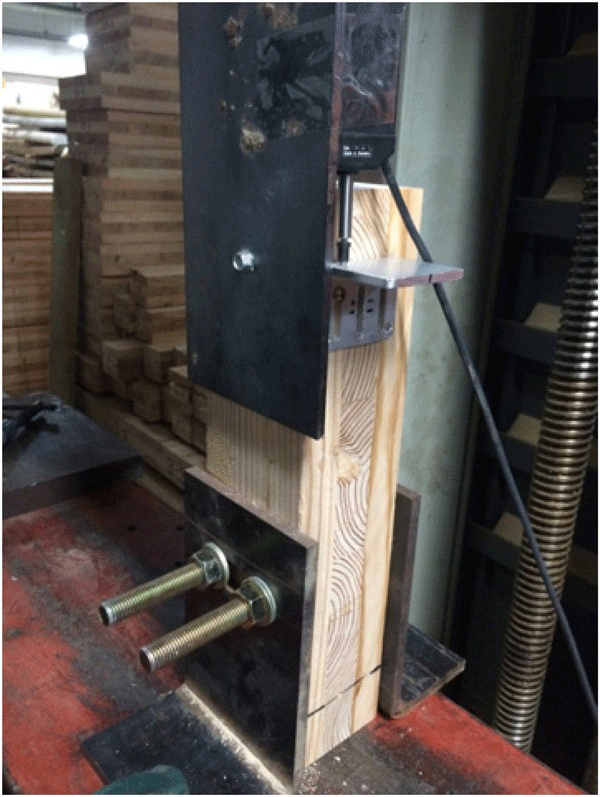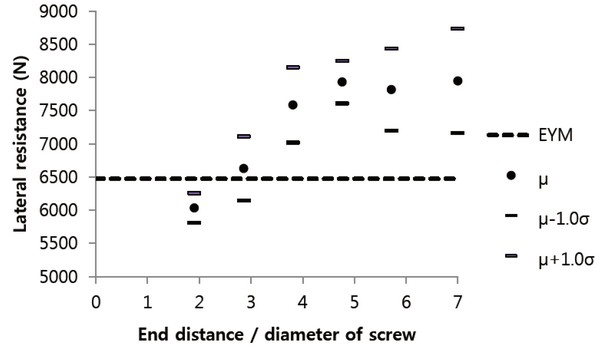1. INTRODUCTION
Cross-laminated timber (CLT) is a relatively new timber building material. This new material is one of the best lateral force resisting elements, shear wall. It has a high shear force resistance that is almost rigid material. But the CLT panels are fabricated at manufacturing factories and those need to be transferred into construction site and to be assembled at field. Because of the regulation in transportation and the size of manufacturing facility, it has a limitation in panel size. It cannot be made a large shear wall with a single panel dislike reinforced concrete, which can make a large wall with a single concrete piece at a construction site.
Therefore, a CLT shear wall needs connections between panels. The performance of the shear wall depends on the shear force transferring capability of the connections (Oh et al., 2016).
In CLT structure, the performance of the structural element, such as shear wall and diaphragm, is governed by the performance of connection. Therefore, many connections have been developed to make better performance structural element, recently. In connection design of CLT structure, European yield model (EYM) can be used (Karacabeyli and Douglas, 2013).
In timber connection, fasteners have to be installed with a certain distance away from the end of panel. If screws were installed too close to the end, the wood member may be split prior to the connections yielded and the connection cannot provide its intended performance. To prevent this unintended failure, building codes specifies to install screws a certain distance away from the end, which calls “end distance”. Korean building code (KBC) and National design specification (NDS) is limiting the end distance as 7D (7 times larger than diameter of dowel) for most of glued-laminated timber.
Dislike glued laminated timber; laminae in CLT panel are cross-wisely glued like plywood. In this case the cross layer may prevent wood from splitting. If the cross layer prevents the splitting efficiently, the reduced end distance for CLT can be used. The shorter end distance may let more versatile connector designs possible (e.g. available to install more screws and more rigid shear wall).
In this study, prior to developing novel connection for CLT, the availability to use shorter end distance was experimentally investigated.
2. MATERIALS and METHODS
In this study, 12 pieces of specimens were prepared (98 mm × 90 mm × 380 mm). Three-ply CLTs were prepared, in which lamination has 30 mm in thickness, 105 mm in width. Species was domestic larch (Larix kaempferi). To investigate the influence of end distance on yield strength of the single shear CLT-to-steel connection, 6 different test sets of end distance were prepared from 1.90D to 7D.
As Fig. 1 shows, one end of specimens was fixed on the bottom frame of universal testing machine (UTM) by “L” shape steel holder (10 mm thickness steel plate) and two bolts of 14.75 mm in diameter. At the other end, a CLT-to-steel connection was installed. The CLT-to-steel connection was manufactured with 5.75 mm thick steel plate and 6.3 mm diameter screw (Strong-Drive® SDS HEAVY-DUTY CONNECTOR Screw, 83 mm in length). The steel plate was fastened at the load cell of the UTM. Linear variable differential transformer (LVDT) was installed to measure the deformation of the connection (Fig. 1).
The steel plate was pulled up to the maximum load. The yield strength was measured for each end distance group. The yield strength for each piece was evaluated by the 5% offset method according to ASTM D5652.
For prediction of yield strength by EYM, bearing strength was measured in different two direction of wood fiber. Two pieces of domestic larch were clamped first and a screw was driven between the two pieces of wood. After unclamping, a pieces of wood, which is half-hole specimen, was used in bearing strength measurement. Finally seventeen pieces of specimens were prepared to measure dowel bearing strength in two different grain directions, respectively. By ASTM D 5764 standard, dowel bearing strength was measured (Fig. 2).
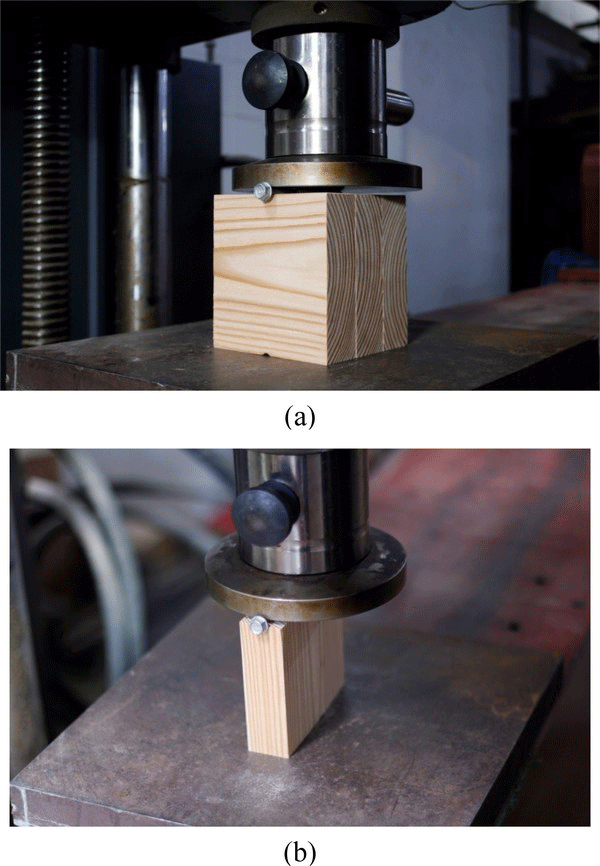
With the dowel bearing strength, the yield strength of the single shear CLT-to-steel connection was predicted by the European yield model (EYM), which is described in detail in CLT handbook (Karacabeyli and Douglas B. 2013).
In order to consider the lower bearing strength in perpendicular to the grain than that in parallel to the grain, main member dowel bearing length of the typical EYM was adjusted by eq. (1).
, where
t‖, i : Thickness of i th layer oriented in parallel to the grain (load direction),
t⊥, j : Thickness of j th layer oriented in perpendicular to the grain (right angle direction of load),
ladj : Adjusted bearing length of main member,
F‖ : Bearing strength in parallel to the grain, and
F⊥ : Bearing strength in perpendicular to the grain.
From yield mode Im to IV, yield load was calculated by eq. 2-1 to 2-6, Out of the six yield load, the minimum load was chosen as the yield load of the test specimen. In this calculation the adjusted bearing length was applied for lm and reduction term, which is safety factor in this test setup (angle between load and grain direction), was not applied.
, where
D : diameter,
Fyb : dowel bending yield strength,
Rd : reduction term, 1.0 in this study,
Re : Rem/Fes,
Rt : lm/ls,
Lm : main member dowel bearing length,
Ls : side member dowel bearing length,
Fem : main member dowel bearing strength, and
Fes : side member dowel bearing strength.
The test results were compared with the EYM-predicted yield load.
3. RESULTS and DISCUSSION
Six different test groups according to end distance were tested and the yield strengths were measured (Table 2). As Fig. 3 shows, Over 24 mm (3.81D) groups showed similar yield strength and even 30 mm (4.76D) showed not lower yield strength than 36 mm (5.71D). But 12-to-18 mm groups showed lower yield load than over 24 mm (3.81D) group. The yield load did not show significant resistance reduction at over 24 mm (3.81D) end distance.
In failure mode, 36 and 44.1 mm (5.71D and 7D) did not show tearing-out or splitting failure and the screw bending was the main failure mode (EYM, IV mode). In case of the 12, 18, 24 and 30 mm (1.90D, 2.86D, 3.81D and 4.76D), the wooden part was torn out by the head of screw. However, in 24 and 30 mm (3.81D and 4.76D), the most of screw part remained in wood even after peak load and only head part of screw got out of the wood toward the end section. But in case of 12 and 18 mm (1.90D and 2.86D), the screws tore woods and most of screw got out of the wood specimen through the end section.
In case of 24 and 30 mm (3.81D and 4.76D), the screw was bent and only head part got out of the wood, therefore, the failure mode was considered as EYM IV mode. This different failure mode between 24 to 44.1 mm (3.81D to 7D) and 12 to 18 mm (1.90D to 2.86D) seems to be the reason of the different yield load between them.
The below 2.86D end distance seems not to be sufficient when looking at the failure mode and yield load. The 3.81D and 4.76D showed the similar yield load as over 5.71D but those were distinguished from over 5.71D in failure by the screw head part. In conservatism, it appears that it is possible to reduce the end distance from 7D to 6D because it did not show resistance reducing and unintended failure like tearing out. Typical failure modes were shown in Fig. 4 and 5.
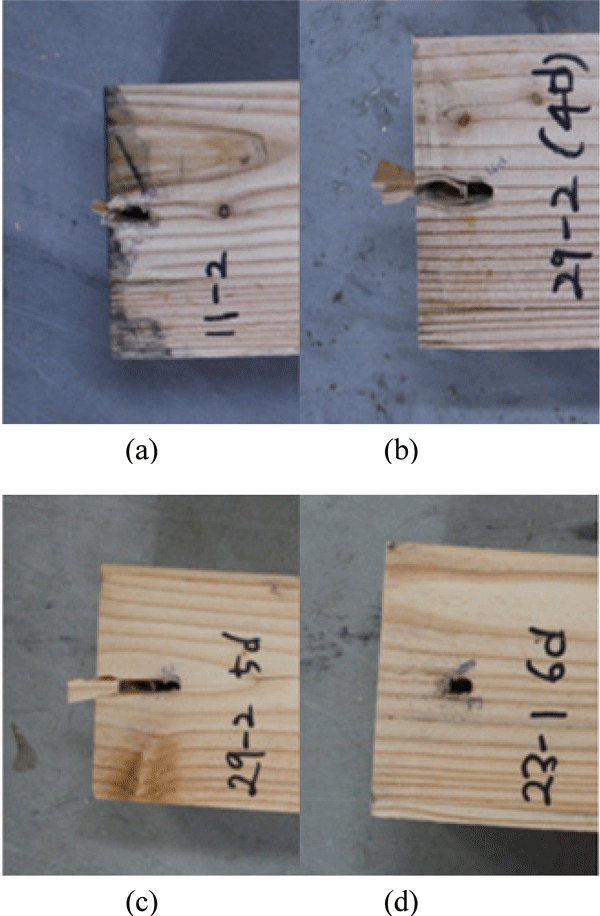
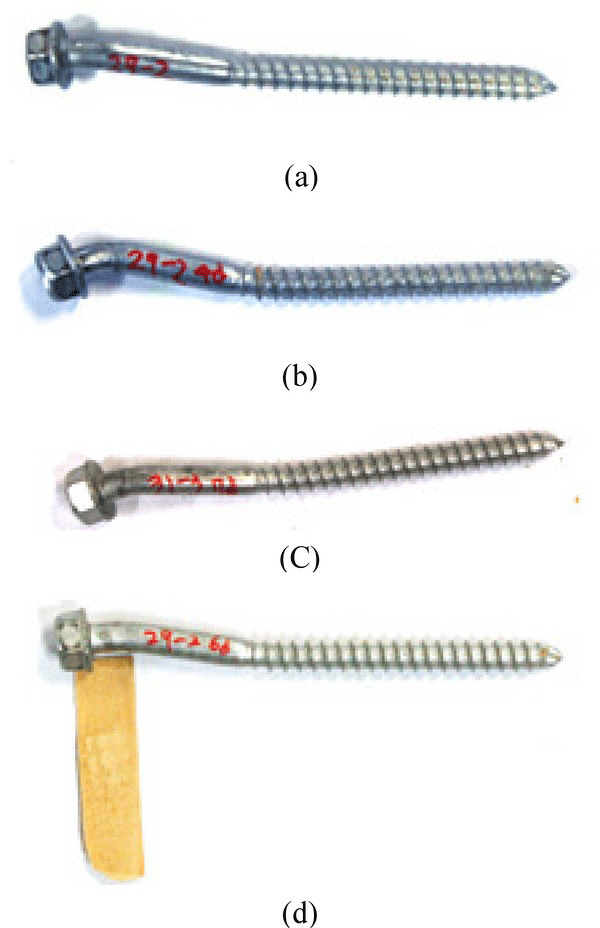
The yield load and the failure mode may show the availability to relax the end distance limitation into 6D by relative comparison with current end distance requirement. In this clause, it was investigated whether the design procedure can provide appropriate design yield load by comparison with experimental result. The yield load of the single-shear CLT-to-Steel connection was calculated by current design procedure. In case of CLT connection, CLT hand book specified the method to calculate the yield load of single-shear CLT-to-steel connection (Karacabeyli and Douglas, 2013).
The cross layer of CLT is crossly laminated; therefore, the different direction has to be considered in yield load calculation. The current KBC and NDS specified the same bearing strength even in different direction. The reason why they have the same bearing strength may be conservative decision by considering only lumber and glulam. Whale and Smith (1986) reported the difference between parallel- and perpendicular-to-grain directions about nail connection. For more precise calculation, the bearing strength was measured in this study. The test resulted different bearing strength between parallel-to-grain and perpendicular- to-grain direction (Table 1). Parallel-to-grain bearing strength was higher than perpendicular- to-grain direction, approximately 30%.
EYM-predicted yield load of the tested CLT-to-steel connection was 6473N when being based on the measured bearing strength, which was different according to load direction. As expected over 4D end distance showed higher than the EYM prediction (Fig. 2). Also, EYM model predict the same failure mode (mode IV) as the measured. From this analysis, it was concluded that European yield model can predict the failure mode of the connection and also the yield load of the single shear CLT-to-steel connection.
As Fig. 3 shows, over 6D was located in the safe side which showed higher yield load than EYM-calculation.
4. CONCLUSION
This study was aimed to experimentally investigate the possibility to relax the end distance requirement in CLT-to-steel connection. Due to the holding capability of cross layers may prevent wood from splitting and tearing- out at the end of wood member, the CLT-to-steel connection was expected to work properly even in smaller end distance than glulam/lumber.
The experiments in this study showed that the end distance can be reduced into 6D, in case of the tested CLT combination and screw, where the test specimens were single shear CLT-to-steel connections made of 6.3 mm diameter screw and CLT which consist of 30 mm thick laminae. But for building code revision or legislation of building code for CLT, further experimental studies are required on various types of screw and lamina combinations.









